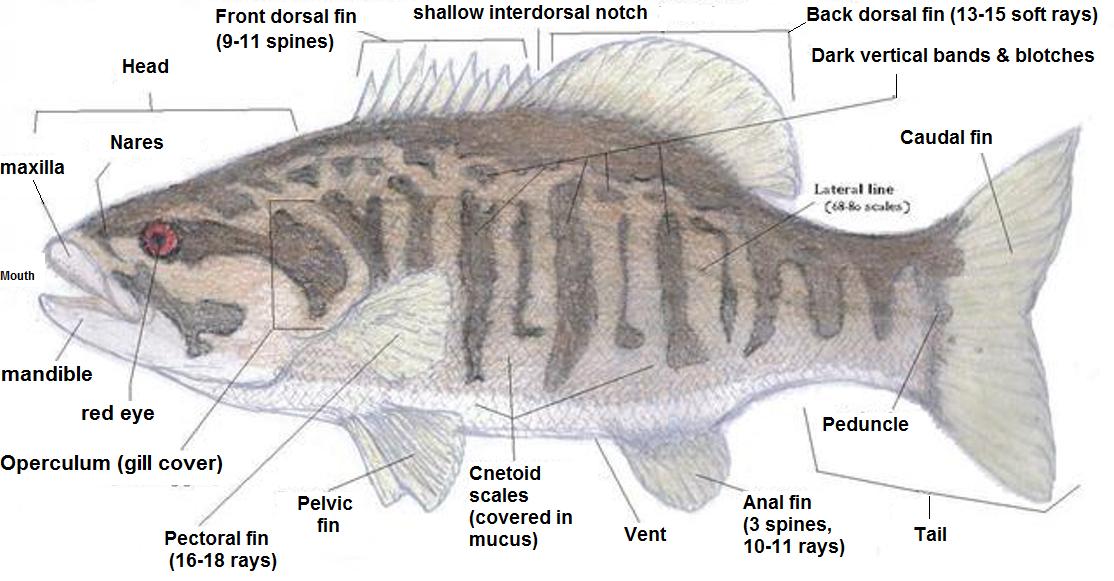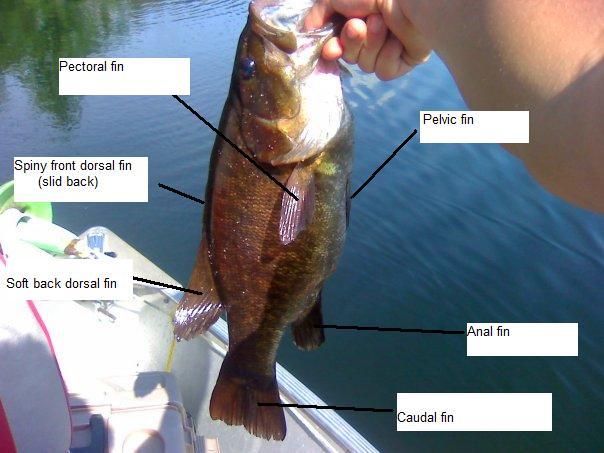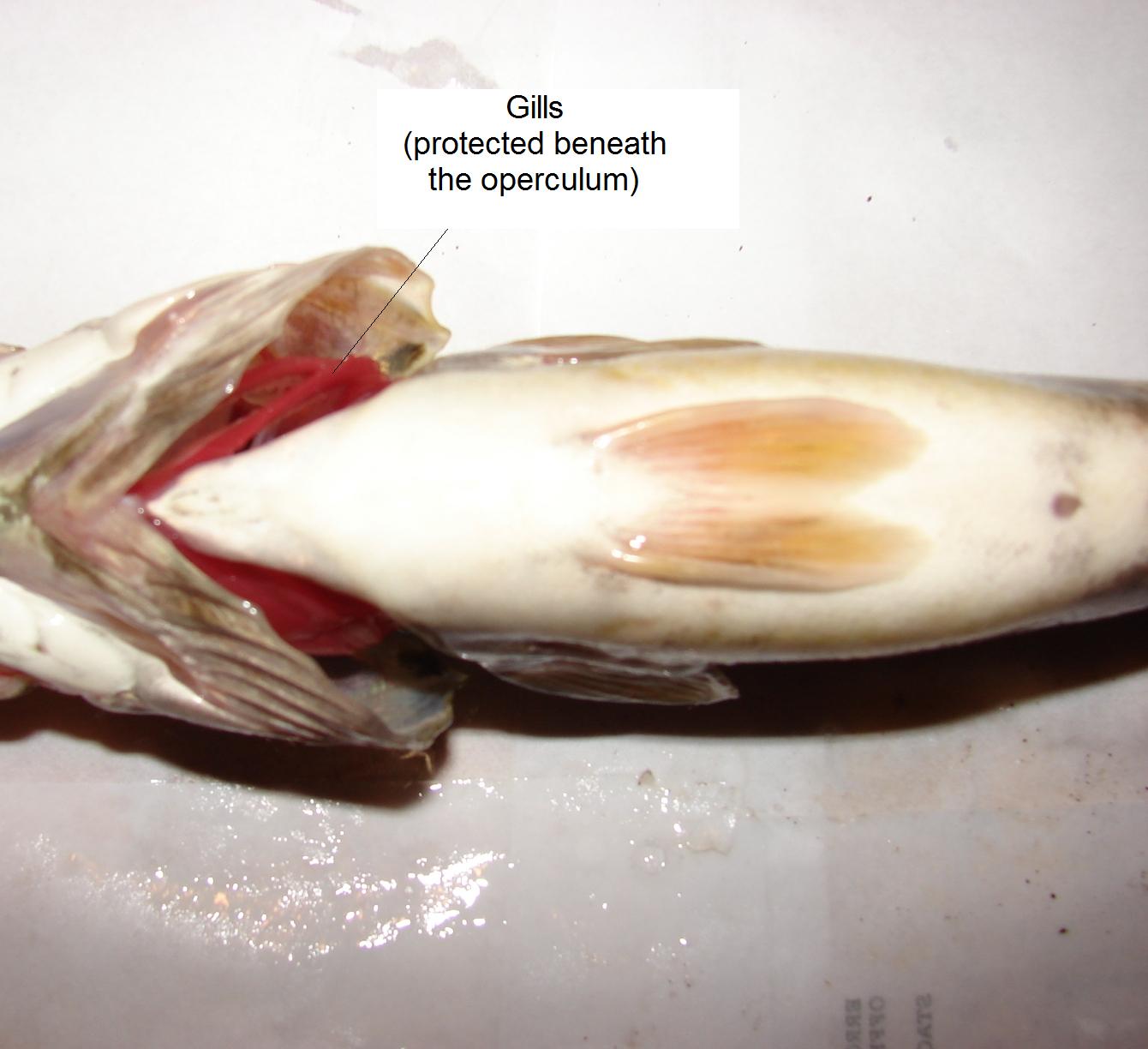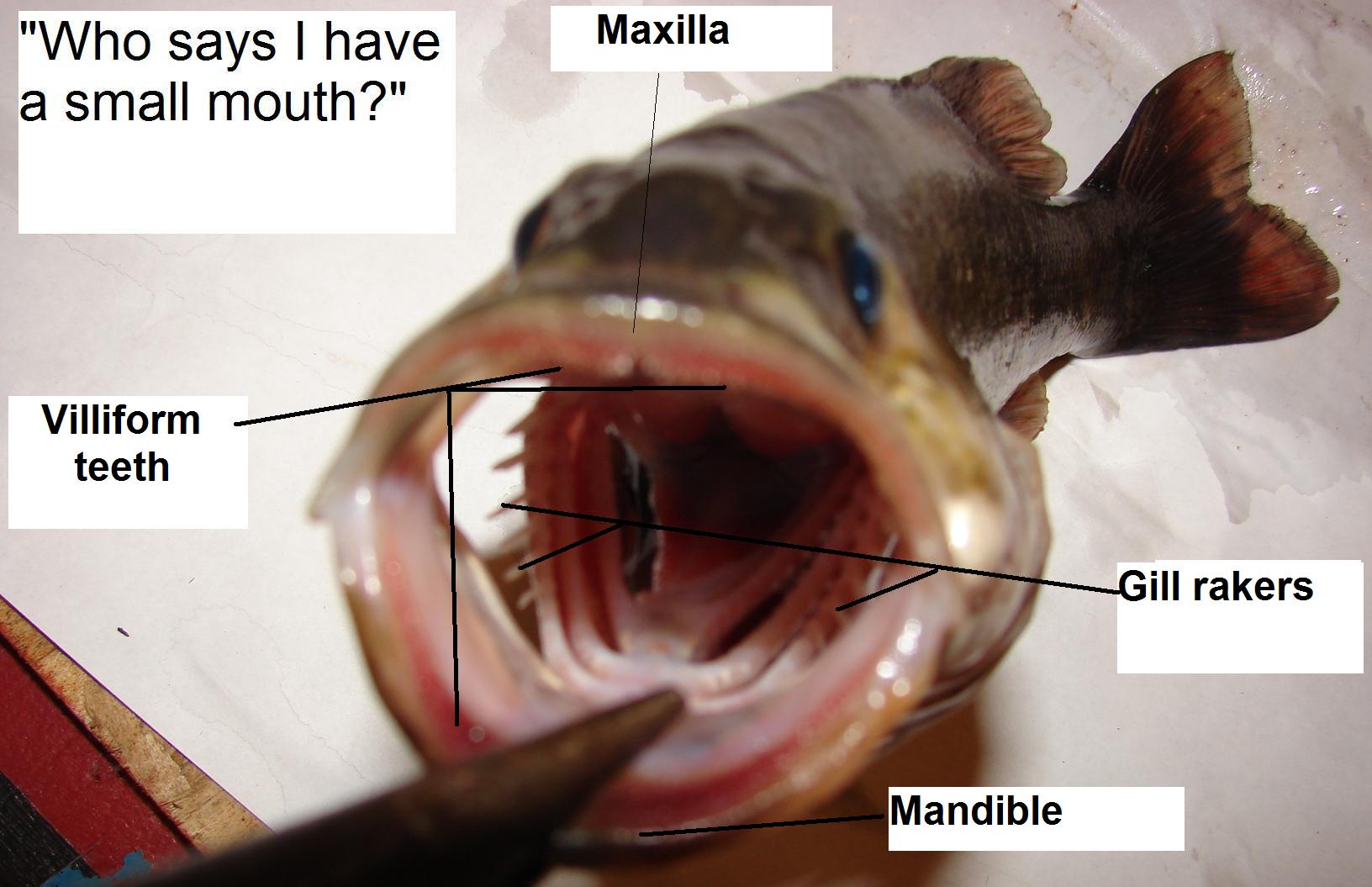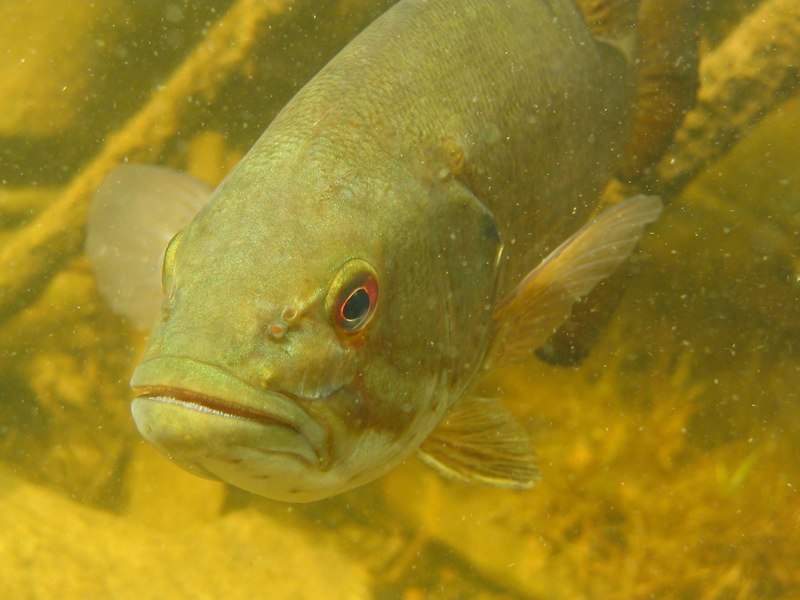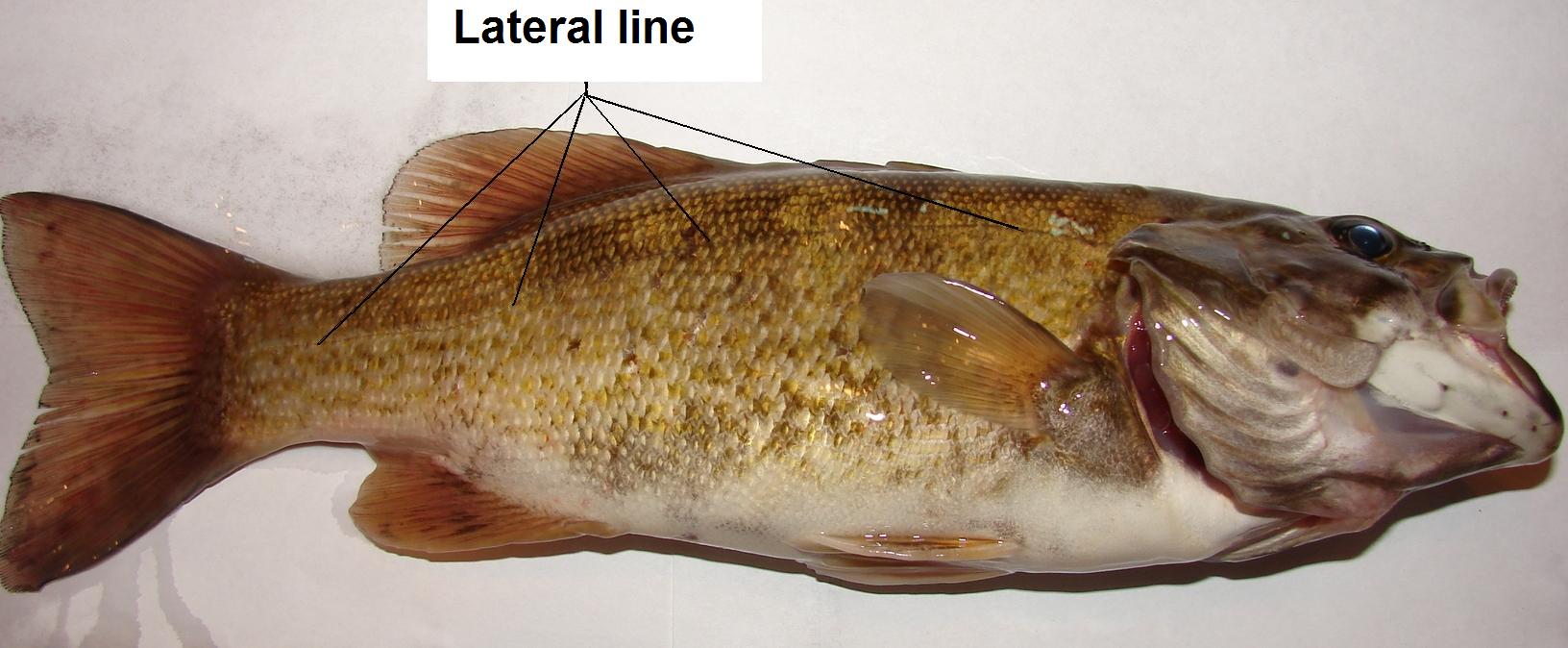SMALLMOUTH BASS
(Micropterus dolomieui)
Dustin Hetke
BIO 203: Organismal Biology, UW-La Crosse
Adaptive morphology & sensation
The smallmouth bass benefits from a wide variety of
morphological adaptations that contribute greatly to its success
and survival as a predatory fish species. Below is a
labeled drawing of the smallmouth's external anatomy, which I
had the pleasure of creating myself. For a larger view of
this image, simply click on it:
Covering the body externally is a protective layer of semi-overlapping scales, which are waterproof and lathered in a thick film of mucus. These mucous, calcified plates provide the fish with a physical barrier for resistance against potential infections and diseases, while also reducing drag during swimming. The smallmouth’s ctenoid scales exhibit a rough morphology, bearing tooth-like margins and circuli (growth rings) that can be counted to approximate the smallmouth’s age. The coloration of a smallmouth’s scales holds important meaning as well. Its body typically exhibits a variable mixture of golden-brown, bronze, and olive-green hues, designed to allow the fish to blend in to its surroundings quite well, which often include sand, gravel, and rocky substrates (see Habitat range & characteristics).
 In comparison, this adaptive camouflage is also found in the
closely-related
largemouth bass, whose green coloration reflects its
often weed-laden habitat preference. Even within its species,
smallmouth from different bodies of water exhibit a fair level of
chromatic diversity, influenced by factors such as the amount of
particulate matter and light penetration in the water. The sides
and back of the bass are always darker than the underside, which is a
lighter, creamy white. In adults, the body’s counter-shading
primarily serves as a form of concealing the hunter from prey that may
be above or below it in depth. Prey from above have a difficult
time distinguishing the bass from the darker water below, while also
struggling to see their stalker from more brightly lit areas above.
For young or juvenile bass, this same counter-shading mainly serves as a
means of being less detectable to larger predators.
In comparison, this adaptive camouflage is also found in the
closely-related
largemouth bass, whose green coloration reflects its
often weed-laden habitat preference. Even within its species,
smallmouth from different bodies of water exhibit a fair level of
chromatic diversity, influenced by factors such as the amount of
particulate matter and light penetration in the water. The sides
and back of the bass are always darker than the underside, which is a
lighter, creamy white. In adults, the body’s counter-shading
primarily serves as a form of concealing the hunter from prey that may
be above or below it in depth. Prey from above have a difficult
time distinguishing the bass from the darker water below, while also
struggling to see their stalker from more brightly lit areas above.
For young or juvenile bass, this same counter-shading mainly serves as a
means of being less detectable to larger predators.
While the
largemouth has a dark vertical streak
along its sides (photo above right), the
smallmouth
bass has several dark bars and
blotches arranged vertically (photo to the left). These bands tend to fade as the fish ages, although they often reappear
through variable expressivity, which has been observed during the
colorful courtship of males and females prior to spawning. The
longest row of scales along the smallmouth’s cheek is between 15-18
scales in length, relative to a
largemouth’s 10-11.
Swimming is the physical motion by which a fish achieves motility. Swimming is important for much more than the promotion of sufficient water flow through the gills. As a heterotrophic organism, the smallmouth bass must obtain energy by consuming other organisms. If this predatory fish could not swim, it would obviously be deprived of its ability to catch prey. Swimming is accomplished by propulsive movement of the tail (caudal fin) to and fro in a rhythmic alteration; action potentials generate a wave of contractions within the strong bands of muscle along one side of the body, followed by those on the other side.
The S-shaped, vertically arranged segments of muscle incorporated
with swimming are called myomeres. The smallmouth’s body is
slender but very stout and robust; it exhibits a fusiform (streamlined)
shape, resembling a torpedo. This is a reflection of its predatory
lifestyle, which often calls for enough speed to chase down fleeing
prey
items. Its body is about twice as deep as it is wide, while its
head usually spans about a third of the smallmouth’s overall body
length. While the long, sleek
body of a
Northern pike or
muskellunge is very hydrodynamic and optimal
for high-speed pursuit of prey in open water, the short and
ultra-compressed body of most panfish (bluegills,
crappies, etc.) is optimized for high
maneuverability to escape predators within the tight quarters of heavy
cover. In essence, the smallmouth’s body form is practically
adapted for a compromise between the two. Below, fellow friend and
angler Dan Thompson displays the streamlined body of a massive
smallmouth:
The smallmouth’s fins are comprised of rays that are covered by a web-like membrane. All of them, to variable degrees, function in maintaining a stable and balanced orientation in the water. The spiked rays that comprise its front dorsal fin are likely adapted to discourage potential predators from obtaining a painful meal. Because the bass is a relatively large and fearless predator when full-grown, this trait is perhaps less applicable to the smallmouth and largemouth basses relative to smaller members of the sunfish family (Centrarchidae), like bluegills and crappies, which are more likely to be preyed upon. Would you be likely to eat something with a spiked back that can stab into the roof of your mouth? Or get stuck in your throat and choke you to death? Fellow angler and friend Jake Thompson displays the spiky front dorsal of a smallmouth bass below:
This spiny dorsal fin (9-11 spines) is followed by a softer dorsal fin (13-15 rays), running along the top of the smallmouth’s back. The hard and soft dorsal fins are separated by a shallow notch, which makes them appear more continuous with each other; this notch is much deeper and more pronounced in largemouth. Pectoral fins reside behind the gills, one on each side of the body, while a pair of pelvic fins lies in a region below the pectoral fins, between the lower mouth and the belly. Aside from aiding in balance, the dorsal and pectoral fins are employed to aid the fish while changing direction, hovering in place, or during rapid bursts of forward motion. The pelvic fins, along with the anal fin (3 spines and 10-11 rays), provide further stability and balance. A smallmouth’s pectoral fins have 16-18 rays, while a largemouth’s have 14-15. Furthermore, the soft dorsal and anal fins are coated by micro-scales across their membranes, a trait not expressed in largemouth.
In conjunction with the fins, the swim bladder is a sac filled with air that aids the smallmouth in maintaining neutral buoyancy and exploiting various depths within its aquatic habitat. Unlike sharks, such as the great white or bull shark, smallmouth aren't required to swim indefinitely to achieve efficient respiration. The swim bladder provides them with the ability to hover in a rather docile and motionless state, or remained suspended at various depths. To rise, gases are transferred from the blood to the swim bladder, thus reducing the density of the fish relative to the surrounding water. This process is reversed when a fish descends.
A
smallmouth bass performs aerobic respiration much like virtually any
other species of fish: through the process of ventilation. It
acquires dissolved oxygen from the water via gills, which serve as air
pumps for water entering through the opened mouth as it swims. Its
gills consist of an intricate network of featherlike filaments, which
house capillaries that perform countercurrent gas exchange. Oxygen
is supplied to deprived tissues, while carbon dioxide is expelled.
This
countercurrent exchange is possible because the concentration of oxygen
is lower inside the bass
than in the water; likewise, the concentration of carbon dioxide is
greater inside the bass than in the
surrounding water. The one-way diffusions of these two gases is
always favored from high to low concentrations.
A hard, body plate called the operculum resides over the gills to
protect these delicate, highly vascularized organs of respiration.
Aside from ventilation, this countercurrent exchange also helps the ectothermic
bass maintain a relatively stable body temperature.
Coordinated movements of the jaws and operculum push water through the gills to facilitate respiration when the bass is not swimming. To
find out more about the smallmouth’s circulatory system, check out
Diet & metabolism.
While oxygen is extracted from water via countercurrent gas exchange, water itself is obtained by the smallmouth (and other freshwater fish) by absorption via osmosis through the skin and gill membranes. Because the concentration of salt and other solutes in freshwater is lower than that inside the fish, the smallmouth is hypertonic in relation to its aquatic environment. This steep osmotic gradient favors the bodily intake of substantial amounts of water. While water is an obvious must for chemical reactions to take place within the body, and therefore the fish’s survival, the smallmouth has no choice but to take in much more than it actually needs. To necessarily combat this gradient, for purposes of maintaining adequate solute concentrations in its blood, the smallmouth continuously excretes dilute urine through its vent. Its kidneys are vital to the process of osmoregulation, working hard to retain solute ions and excrete all of the excess water; they also work to filter out and remove nitrogenous wastes from the blood. Amongst other things, the ion balance maintained by the kidneys is crucial in sustaining adequate pH levels in its bodily fluids.
Contrary to what its common name implies, the smallmouth bass has a relatively large mouth for its body size when compared to many other fish species. Its rather condescending pseudonym probably would not exist if not for the gigantic and wildly disproportional maw of its close relative, the largemouth bass. As a rule of thumb, the smallmouth’s maxillary (upper jaw) extends backward no further than a line perpendicular to its eye; the largemouth’s maxillary extends backward a noticeably further distance. While smaller, narrow, and more pointed, the smallmouth’s oral opening is still easily large enough to inhale and devour significantly large prey items. Some hypothesize that the smallmouth’s jaws have adapted according to their tendency to scan the bottoms of lakes and rivers, facing downward as it probes rock crevices to snatch to crayfish.
To ingest food, both smallmouth and largemouth tend to engulf, inhale, and swallow their prey whole, unlike other species that use large, sharp teeth to bite and tear their food into smaller pieces. Bass do have tiny bands of villiform teeth that are barely noticeable to the unaided human eye. These teeth face inward and are coarsely distributed along the interior surfaces of their upper and lower jaws, palatines, pharynx and vomer. The size and orientation of its teeth reflect their function of grasping and holding onto prey items to prevent them from escaping. If you have ever held a bass by placing your thumb inside its lower jaw, you may have noticed that its teeth have a rough, bristle-like texture that feels a lot like sandpaper or the end of a brush; oftentimes, after holding multiple bass on the same day, these tiny teeth will leave negligible tears and indentations on the skin of your thumb. Rows of bony projections along the gill arches, called gill rakers, also function in retaining swallowed prey items and preventing them from escaping through the gill openings. For further information on food acquisition, digestion, and nutrient uptake, please see Diet and metabolism.
The smallmouth’s internal framework is provided by an ossified
endoskeleton (made of bone), comprised primarily of a vertebral column,
which houses the spinal cord, and a cranium (skull) that encases the
brain. The bony skeleton’s flexibility promotes sufficient
movement during swimming; its strength and rigidity provides support and
protection for the entire body. It also grows along with other
body tissues and providing points of attachment for muscle. The
smallmouth bass (and other fish) don't receive many accolades in the
intelligence category. In its defense, however, the smallmouth’s
brain has still adapted nicely for performing functions related to the
processing of information that is applicable to its survival.
Generally, the brain is responsible for receiving environmental stimuli
as input, which it interprets quickly and instinctively acts upon as
output. Aside from instinctual responses to changes in the
environment, the brain also exerts a certain level of control over
autonomous functions, such as respiration and heartbeat.
The smallmouth bass utilizes a wide variety of sensory adaptations that are essential for its predatory lifestyle, and therefore survival. It is primarily a visual hunter, although the extent to which it relies upon sight varies accordingly with conditions such as water clarity and light penetration. In a clear water environment with decent light penetration, sight is the smallmouth’s dominant sense by a landslide. Being its most common means of finding food, the smallmouth’s eyes are undoubtedly well-adapted for the task. Water has a higher refractive index and absorbs more light than air, making it a generally poor medium for light to travel through. However, the bass’s eyes are pretty well-adapted to compensate. Its fixed-focus pupils can take in substantial amounts of light because a fair majority of the large, rounded eyes is externally exposed. It has been estimated that bass eyes are capable of receiving about five times more light than that of humans. The lens cannot shape, but can be moved in and out to achieve some focus via retractor muscles. To adjust to varying degrees of light intensity at dawn or dusk, the irises open and close, although their mobility is limited. Each eye, located on its own respective side of the head, boasts an incredibly wide field of vision (180 degrees). Directly in front of the bass and slightly upward, the monocular fields overlap to employ binocular vision, which is most acute. The ability to see prey or potential danger from so many angles is a tremendous advantage that smallmouth bass utilize; directly below and behind the bass are relatively insignificant blind spots. Rods within the retina provide for black and white vision (along with shades of grey), while cones allow for distinguishing between various intensities of colors. These photoreceptors, which generate signals that are carried to the brain via an optic nerve, allow smallmouth to discriminate and choose between potential prey items. While nictitating membranes (eyelids) are absent, a specialized black pigment is present to shade the retina’s most photosensitive cells and promote vision under heavy sunlight. The smallmouth bass has been known to use differences in light intensity to their advantage in their hunting techniques. Oftentimes, this predator will obscure itself somewhere in a shaded area with reduced light penetration, where it can easily see prey swimming by; meanwhile, the prey have a difficult time spotting danger when looking into a shaded area from a bright one; hence, circumstances are ripe for the smallmouth to launch a surprise attack.
When a smallmouth faces reduced water clarity, it may be forced to
rely on other senses that would normally only serve to supplement vision
as the dominant sense. The bass has two pairs of nares (nostrils),
one pair on each side of the snout and posterior to the upper jaw.
While they hold absolutely no respiration function, they do house a
wealth of chemoreceptors that play an important role in the smallmouth’s
sense of smell. Some believe that a bass’s sense of smell is
a thousand times stronger than a dog’s. That notion alone should
be enough to convince you that a smallmouth’s olfactory system is very
legitimate, as dogs are thought to smell a thousand times better than we
humans do! As water carrying odorous molecules circulates into
and out of the nares, the smallmouth’s olfactory system is activated.
The internal passageway between the nares and the chemoreceptors is
lined with olfactory epithelium, which is a membranous tissue studded
with hair-like cilia. These cilia are associated with olfactory
nerve cells, which send signals to the brain’s olfactory centers upon
stimulation. Interpretation by the brain allows the smallmouth
bass to discern the possible source of the odor. While the smell
of wounded or distressed prey does induce an instinctual response to
feed, the smallmouth’s olfactory sense often serves more important
functions outside of predation. In fact, olfactory sense is the
primary way that this fish avoids harmful environmental conditions, such
as abnormal pH, low dissolved oxygen content, or even pollutants.
Furthermore, some hypotheses suggest that intra-species communication,
or the way by which smallmouth “talk” to each other, relies on the basis
of each individual giving off distinctly identifiable odors called
pheremones (a type of horomone). In essence, they know each other
by smell rather than name, and more or less talk to each other by these primitive means.
In this regard, male and female smallmouth may also use smell to cue
each other to initiate spawning behavior.
Taste is another olfactory sense that the bass utilizes, usually to
decide whether or not a recently engulfed prey item is worth swallowing
or spitting out. This is made possible by the saturation of its
mouth and lips with thousands of taste buds. The smallmouth is
also believed to have a sense of touch or feel in regards to the texture
of a food item. These senses, along with olfaction, are among the
smallmouth’s most primitive and short-ranged means of sensing its
environment.
Hearing, which is actually the smallmouth’s most acute sense, is another way that bass supplement their vision to gain a better perception of their environment. Because sound travels up to five times faster in water relative to air, the bass usually hears prey before using its vision to zone in on its location. While it lacks a cochlea, which would normally discriminate pitch, it otherwise harbors a complete auditory system. The inner ear, comprised of a body structure within the skull, usually picks up high-frequency sound waves that travel through the water and penetrate the body; while very sensitive, the bass usually has a difficult time discriminating the location of the sound source when relying solely on its inner ear. The smallmouth’s lateral line (68-80 scales in length), on the other hand, is incredibly effective at honing in on and pinpointing the specific sources of lower-frequency vibrations, particularly within a close vicinity.
A lateral line consists of highly specialized and very sensitive nerve endings called neuromasts, which form a narrow band that runs horizontally down the length of each side of the body, culminating at the caudal fin. Vibrations caused by something as subtle as water displacement can lead to very accurate lateral line perception. These nerve endings are modified mechanoreceptors, which specialize in detecting pressure changes. They are bordered internally by muscle tissue, and superficially by the scales. Sounds so subtle as the fluttering of a wounded fish often elicit a strong instinctual response from the bass, for its very nature as a predator depends upon capitalizing on a food opportunity when it perceives prey as vulnerable. While it is more difficult to pinpoint the sources of pressure changes from great distances, the lateral lines can allow the bass to detect sound from over a hundred feet away. Despite being a supplementary sense, a smallmouth’s sense of hearing has the most distant range of perception, actually doubling its visual capacity.
When it comes to sound, most of the attention is paid to how smallmouth bass respond to it. However, while the bass is typically a silent creature, it has been known to produce some noise when certain circumstances call for it. To discourage egg-snatching intruders from coming any closer to his spawning bed, or to ward off other males hoping to steal his female mate, the male bass has been observed flaring its gills and slamming its operculi shut as a form of intimidation. Such an act is usually enough to make the challenger think twice before trespassing on Mr. Bass’s territory again. For further details concerning this and other interactions between the smallmouth bass and other species, view Interspecies relationship dynamics.
Now that you've learned about how the smallmouth bass benefits from a plethora of adaptations, perhaps you would like to learn about its nutritional requirements and patterns of prey consumption.
(Return to home page)
